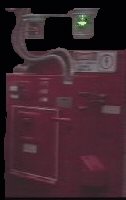

|
 The containment unit is where we store the ghosts we capture on a permanent basis. It's basic workings are very similar to the ghost trap. Within the outer shell is a steel grid which, like the trap, has been given a strong positive charge. Unlike the trap, however, the containment unit's grid is very powerful and capable of holding thousands of ghosts at the same time.
The containment unit is where we store the ghosts we capture on a permanent basis. It's basic workings are very similar to the ghost trap. Within the outer shell is a steel grid which, like the trap, has been given a strong positive charge. Unlike the trap, however, the containment unit's grid is very powerful and capable of holding thousands of ghosts at the same time.
There is a simple set of steps that you will follow to relocate a captured ghost from the trap to the containment unit.
- First you unlock and open the outer door. Insert the trap in the holding matrix. The trap's containment grid will automatically detach from the handle assembly, which can be set aside for the moment. Once the trap is loaded into the unit's door, close and relock the system. If all has gone well a red light will activate at this point.
- Second you must set your entry grid. This activates a negative field around the trap so the ghost cannot escape during the transfer process. If it tries, it's own negative charge will repel that of the entry grid's negative charge and the ghost will be forced back into the entry passage.
- Third you will neutranize the field. This adds neutrons to the entry grid, thus enforcing it in case the ghost decides to become rowdy. This step is simply a precaution, but it is standard procedure to follow it at all times, just in case.
- Finally you pull what we have jokingly labeled "the switch". This action activates a strong positive charge within the entry passage, at the same time shutting off the trap's power. The positive field pulls the ghost through the trap wall and into the containment unit. It is important to note that the trap does not physically open, the ghost is simply pulled through the trap wall. Once the ghost is safely incarcerated, the red light will turn off and a green one will activate. As one of my colleges is fond of saying, "Light is green, trap is clean."
The ghost trap is then removed from the containment unit's outer door and given a good cleaning to remove any ectoplasmic residue that might have been left behind.
At any time that the containment grid might become full, it can be enlarged by putting on an addition. The containment unit we use now has undergone many such enlargements.